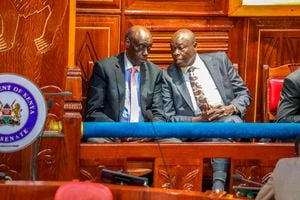Guns go silent in bandit-ravaged regions as locals embrace carbon trading

Community conservancy leaders in northern Kenya perform traditional prayers during a carbon credit awareness event in Kalama, Samburu County, on July 2, 2024. Communities who have been warring for years are coming together to decide on grazing patterns in a bid to restore grasslands and harvest carbon.
What you need to know:
- The eco-revolution, which involves selling carbon to international markets, has been lauded for addressing environmental degradation and fostering peace among warring pastoralist communities in Northern Kenya.
In northern Kenya's arid and semi-arid lands where cattle rustling and resource-based conflicts have been endemic for decades, carbon trading is bringing hope and stability to the region.
Carbon trading is the buying and selling of permits of carbon credits that allow the holder to emit a certain amount of carbon dioxide and other greenhouse gases.
The eco-revolution, which involves selling carbon to international markets, has been lauded for addressing environmental degradation and fostering peace among warring pastoralist communities in the vast region.
The vast rangelands in northern parts of the country inhabited mostly by pastoralist communities have long been plagued by cattle rustling and violent disputes over water and grazing land. These conflicts have led to loss of lives, displacement of people and economic instability, severely impacting the livelihoods of locals.
But now communities who have been warring for years are coming together in a roundtable to decide on grazing patterns in conservancies in a bid to restore grasslands.
They combine traditional and modern methods of grazing livestock to allow grasslands to regenerate and avoid degradation. The Northern Rangelands Carbon Projects then captures atmospheric carbon to sell to international markets.
About 22 conservancy units are involved in the project and are members of the Northern Rangelands Trust (NRT). The community members authorised NRT to sell carbon credits from the project’s activities on their behalf.
The community conservancies involved include Biliqo Bulesa, Il Ngwesi, Kalama, Leparua, Meibae, Melako, Naibunga Lower, Upper and Central, Nakuprat-Gotu and Ngilai West. Others are Nalowuon, Nasuulu, Nannapa, Nanapisho, Narupa, Naapu, Sera, Westgate and Lekurruki, all spread across Laikipia, Samburu, Isiolo and Marsabit counties.
Each conservancy is responsible for creating, implementing and adhering to its own planned rotational grazing patterns to avoid resource-based conflicts and allow the regeneration of grasslands.
After removing carbon, it is then sold as offsets in the global carbon market to earn the local communities sustainable income, support conservation, protect endangered wildlife and even address climate change.
According to NRT Chief Executive Officer Tom Lalampaa, the project has helped reduce resource-based conflicts because communities are coming up with planned ways of grazing livestock to restore grasslands.
The official said the project is being embraced by locals as a mechanism for addressing the root causes of conflict - environmental degradation and resource scarcity.
"Communities have been fighting over grazing resources in northern parts of the country. But now they are sharing resources equally at one table," said Mr Lalampaa.
'The communities also use revenues earned from the sale of carbon to engage morans in meaningful activities, including businesses such as sale of motorcycle spare parts and livestock trading,” he added.
According to Mr Lalampaa, the project is considered one of the world's largest soil carbon removal projects, adding that it has helped the arid region to build climate resilience, conserving wildlife habitats and ending resource-based conflicts.
According to Mr Mohammed Shibia, the Rangelands and Carbon Project Director at NRT, the project seeks to harvest 50 million tonnes of carbon dioxide from the atmosphere over the next 30 years. The first carbon credits were generated in 2013 and offered to the international voluntary markets.
"We have a large area of the project, which spans almost two million hectares, with more than 10 ethnic groups. It calls for more awareness for more people to understand how this project works and its benefits," said Mr Shibia.
Forestry Principal Secretary Gitonga Mugambi recently promised to support local pastoralists in Samburu and other parts of northern Kenya to venture into carbon credits. Mr Mugambi said the carbon offsets sale is a remarkable example of how indigenous people and modern science can mix to address the climate crisis.
"Carbon trading is a new venture worldwide. We will support locals so that they can earn revenue through carbon credits and feel rewarded for conserving their nature," Mr Mugambi said.





